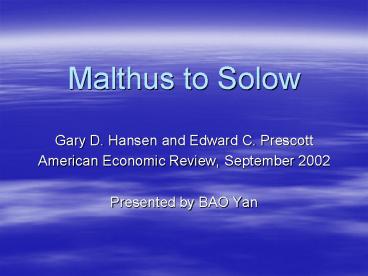Malthus to Solow - PowerPoint PPT Presentation
Title:
Malthus to Solow
Description:
Malthus to Solow Gary D. Hansen and Edward C. Prescott American Economic Review, September 2002 Presented by BAO Yan Objective and Issues Some empirical facts ... – PowerPoint PPT presentation
Number of Views:49
Avg rating:3.0/5.0
Title: Malthus to Solow
1
Malthus to Solow
- Gary D. Hansen and Edward C. Prescott
- American Economic Review, September 2002
- Presented by BAO Yan
2
Objective and Issues
- Some empirical facts concerning preindustrial and
postindustrial English economy. - Two kinds of technologies
- Malthus land-intensive technology
- Solow technology.
- The development (or growth) path from Malthusian
economy to Solow economy.
3
Major Conclusions
- Lands share in production should fall
endogenously over time, as observed historically. - Escape from Malthusian stagnation and transition
to Solow growth.
4
English Economy (1275-1989)
- Period 1275-1800
- Period 1800-1898
5
Analytical Framework
- One-good, two-sector version of
Overlapping-Generations model. Diamond (1965) - Malthus sector
- Solow sector
6
Model Economy
- Firm allocation profit maximization
- Household allocation utility maximization
- Markets clear.
- Demographic structure Kremer (1993)
7
Competitive Equilibrium
- It is always profitable to operate the Malthus
sector. - Maximized profit per unit of output in the Solow
sector is positive if and only if - Both sectors will be operated if and only if the
inequality above is satisfied at the factor
prices obtained under the Malthus economy.
8
Competitive Equilibrium
- Resource allocation across the two sectors
- Given initial conditions, the model determines
the equilibrium sequences - cannot be solved for analytically.
9
Development Path
- Per capita income is constant in the Malthus-only
growth path. - Solow technology will be adopted at some point of
time. - Transition to Solow economy depends upon the
parameters of the model.
10
Quantitative Exercise
Parameter Definition Value
Growth factor in Malthus technology 1.032
Growth factor in Solow technology 1.518
Capital share in Malthus technology 0.1
Labor share in Malthus technology 0.6
Capital share in Solow technology 0.4
Discount factor 1.0
11
Population Growth Function
- Data resource for calibrationLucas (1998) on
population growth rates and per capita GNP from
1750
12
Economy Simulation
- Over 99 of resources are allocated to the Solow
sector after three generations - Value of land relative to output decreases after
the Solow technology is adopted.
13
Simulated Transition
- The decrease of land value relative to output is
roughly consistent with the pattern seen in the
historical data.
14
Simulated Growth Path
- Population grows at the same rate as output and
wage stays constant in the Malthusian period. - Population growth and real wage increases after
industrial revolution.
15
Critical Considerations
- Sources for technological innovation
- Population growth pattern
- Why didnt industrial revolution happen in the
rest of the world? - Why did some countries that did take off result
in stagnation trap? - Growth miracle
16
Possible Extensions
- Different forms of production function
- Institutional effect Jones (1999)
- Economic and political policies Parente-Prescott
(1997) - Family mode transition Galor-Weil (2000)































